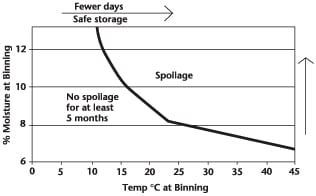
Canola at 10% moisture is at risk of spoilage when binned at 20°C. At 25-30°C, the spoilage risk is that much greater. Canola at 8% moisture is also at risk if not cooled immediately after storage.
The first 4-6 weeks are critical. Canola in storage keeps respiring during that time, releasing moisture into the air around the seed. This moisture moves with air currents inside the bin, and in the fall and winter, this moisture concentrates at the top of the central core.
All canola should be conditioned immediately after harvest. “Conditioning” involves the movement of air through seed to ensure safe storage over a period of time. The basic recommendation is to put canola into aeration bins immediately after harvest and turn the fans on until canola has cooled to 15°C. If aeration bin space is not available, keep moving the canola from bin to bin until it cools.
The risk is even higher with larger bins. With larger bins, there is generally less surface area relative to the volume, meaning natural cooling takes longer. The core will hold that heat longer if not aerated, and larger bins take more loads to fill them so there is a greater chance a load or two might be over 8%.
When using aeration to cool canola that is very dry, fans can be shut off during the day and turned on at night when air is cooler.
Monitor canola throughout the aeration process to make sure the temperature is coming down. Bin temperature cables simplify the monitoring process. If temperatures stop falling or worse, start rising again, this is a bad sign that heating may have begun. Empty the whole bin to break up hot spots and cool off the mass, then put the canola back on aeration.
Green seeds and dockage, including canola plant material, weed material and insect parts, create additional start points for heating and can make the situation worse. Grasshoppers in the windrow at harvest often end up in the bin. These moist decaying bodies often concentrate at bin edges, creating potential hot spots.
